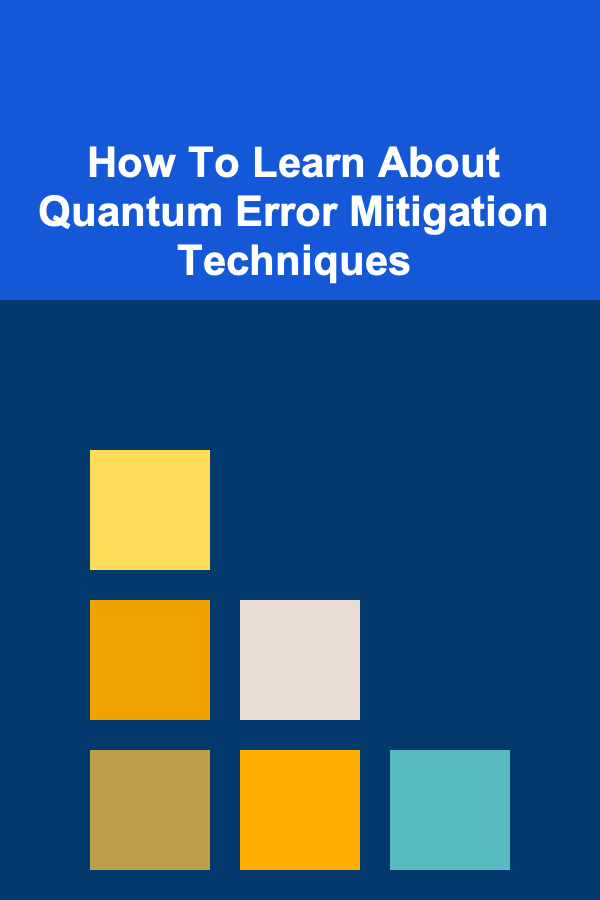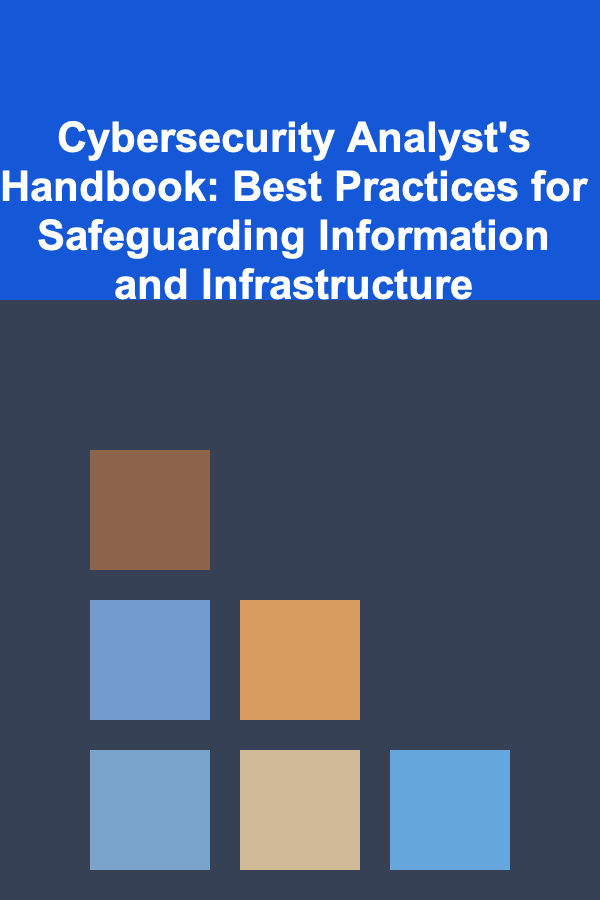
How To Learn About Quantum Error Mitigation Techniques
ebook include PDF & Audio bundle (Micro Guide)
$12.99$11.99
Limited Time Offer! Order within the next:

Quantum computing has the potential to revolutionize many fields, from cryptography and artificial intelligence to drug discovery and materials science. However, despite the promise of quantum technologies, the inherent fragility of quantum states and their susceptibility to errors present significant obstacles to the practical realization of large-scale quantum computers. Quantum error mitigation (QEM) techniques have emerged as a crucial area of research in addressing these challenges. In this article, we will explore the various quantum error mitigation techniques, the challenges they seek to address, and how one can learn about them.
Introduction to Quantum Computing and Errors
Quantum computers differ from classical computers in that they use quantum bits (qubits) to represent and manipulate information. Qubits can exist in superpositions of states, which allow quantum computers to perform certain calculations exponentially faster than classical computers. However, qubits are highly sensitive to external noise and interference, leading to errors in quantum computations.
Errors in quantum systems arise due to various factors, such as decoherence, operational imperfections, and environmental disturbances. While classical computers can correct errors using established error correction codes, quantum error correction (QEC) is much more challenging. The reason for this is that qubits cannot be copied or measured directly without disturbing their state, which makes traditional error correction schemes unfeasible. As a result, quantum error mitigation has become a focal point of research to develop methods that reduce errors without the need for full-fledged error correction.
The Need for Quantum Error Mitigation
Quantum error mitigation focuses on reducing the impact of errors in quantum computations without the need for full quantum error correction. The aim is to improve the reliability of quantum computations on near-term quantum devices, which are prone to errors due to limited qubit coherence times and imperfect gate operations.
Quantum error correction, while theoretically sound, requires a large number of physical qubits to encode a single logical qubit. This overhead makes it impractical for current quantum computers, which typically have a limited number of qubits. As such, quantum error mitigation techniques have emerged as an important alternative. These techniques aim to reduce errors without the computational overhead of full error correction.
Key Quantum Error Mitigation Techniques
Several quantum error mitigation techniques have been proposed and studied in recent years. These techniques fall into different categories, each addressing a specific type of error. Below, we will discuss some of the most widely studied techniques:
1. Quantum Variational Error Mitigation (QVEM)
Quantum variational error mitigation is a technique that seeks to mitigate errors by using variational methods. In this approach, an ansatz (a trial quantum state) is used to approximate the solution to a quantum problem. The variational principle is then applied to optimize the parameters of the ansatz such that the error is minimized.
The technique works by exploiting the fact that errors in quantum computations often affect the output in a predictable manner. By adjusting the parameters of the ansatz, it is possible to reduce the effects of these errors and obtain a more accurate result. This technique is particularly useful in situations where the quantum computer is too noisy for full error correction but where the problem being solved is still within reach.
2. Error Mitigation by Post-Processing
Post-processing methods aim to correct errors after the quantum computation has been performed. These techniques often involve statistical methods or classical post-processing algorithms to extract the correct result from noisy quantum measurements.
One common approach is to use a technique called probabilistic error cancellation. In this approach, a quantum circuit is run multiple times, and the results are combined in such a way that the errors cancel out. This requires knowing the noise characteristics of the quantum system, which can be estimated by running the circuit with different parameters or using auxiliary quantum resources.
3. Quantum Tomography and Error Mitigation
Quantum tomography is the process of reconstructing the quantum state of a system from measurement data. In the context of error mitigation, quantum tomography can be used to estimate the error in a quantum computation and then correct it.
One approach to using quantum tomography for error mitigation is to perform a full state tomography on the quantum system. By comparing the measured state to the ideal state, errors can be identified and mitigated. However, quantum tomography can be computationally expensive, as it requires a large number of measurements, and may not be feasible for large quantum systems.
4. Error Mitigation with Classical Simulations
Another technique for mitigating quantum errors is to use classical simulations to approximate the effect of noise on quantum computations. By running the quantum algorithm on a classical simulator that mimics the noise characteristics of the quantum system, researchers can estimate the effect of noise on the computation and correct for it.
This approach is useful when the noise in the quantum system is known and can be modeled. However, it may not be applicable for more complex noise patterns or when the noise characteristics are unknown.
5. Noise Tailoring
Noise tailoring involves modifying the quantum algorithm or quantum hardware to reduce the impact of noise. This can be achieved by designing quantum circuits that are less sensitive to certain types of noise, or by using error-correcting codes to protect against specific types of errors.
Noise tailoring is an active area of research, and various strategies have been proposed, such as using error-correcting codes, quantum feedback, or noise-resistant quantum gates. By making the quantum system more resilient to noise, it is possible to reduce the need for error correction and mitigate the impact of errors on quantum computations.
6. Qubit Recycling
Qubit recycling is a technique that involves reusing qubits throughout the quantum computation to reduce the number of qubits that need to be error-corrected. In traditional quantum error correction schemes, each logical qubit is encoded using multiple physical qubits. Qubit recycling reduces the number of qubits needed for encoding by reusing qubits that have already been measured or reset.
This technique can be particularly useful for near-term quantum computers, where qubits are limited and error correction requires many qubits. By recycling qubits, it is possible to reduce the overhead of error correction and improve the overall efficiency of quantum computations.
Learning About Quantum Error Mitigation Techniques
To effectively learn about quantum error mitigation techniques, it is essential to gain a solid understanding of both quantum computing principles and the specific methods used to mitigate errors. Here are some steps that can help in learning about these techniques:
1. Study the Fundamentals of Quantum Computing
Before diving into error mitigation, it is important to have a strong foundation in the basics of quantum computing. Topics to study include:
- Qubits and quantum gates
- Superposition and entanglement
- Quantum algorithms (such as Shor's and Grover's algorithms)
- Quantum circuit design and implementation
Books, online courses, and tutorials can be helpful for building this foundational knowledge.
2. Explore Quantum Error Correction and Noise Models
Understanding quantum error correction (QEC) is crucial for grasping quantum error mitigation. Although QEC is not directly used in error mitigation, many techniques are inspired by QEC principles. Key topics to explore include:
- Quantum error-correcting codes (such as the Shor code and surface codes)
- Decoherence and noise models
- Fault tolerance in quantum systems
3. Familiarize Yourself with Quantum Error Mitigation Methods
Once you have a solid understanding of quantum computing and error correction, you can start exploring the specific error mitigation techniques mentioned earlier. Research papers, online lectures, and tutorials from leading quantum computing platforms (such as IBM Qiskit or Google's Cirq) are valuable resources.
4. Experiment with Quantum Programming Languages and Platforms
Hands-on experience with quantum programming languages is an essential step in learning about error mitigation techniques. Platforms like IBM's Qiskit, Google's Cirq, and Rigetti's Forest provide access to quantum simulators and real quantum hardware, allowing users to experiment with error mitigation techniques in real-world scenarios.
By running quantum algorithms and applying error mitigation techniques, you can observe how different methods affect the outcomes and better understand their practical application.
5. Stay Up-to-Date with Research
Quantum error mitigation is a rapidly evolving field, and new techniques and improvements are constantly being developed. Staying up-to-date with the latest research papers, preprints, and conference proceedings is crucial for understanding the state of the art in error mitigation.
Popular journals and repositories for quantum computing research include:
- Physical Review Letters (PRL)
- Quantum (Open access journal)
- arXiv (Preprint repository for quantum computing research)
Conclusion
Quantum error mitigation is a vital area of research that addresses the practical challenges of building reliable quantum computers. While full quantum error correction remains a long-term goal, techniques like variational error mitigation, post-processing, and noise tailoring are making it possible to reduce errors on current quantum devices.
Learning about quantum error mitigation techniques requires a solid foundation in quantum computing, an understanding of quantum error correction, and hands-on experience with quantum programming platforms. As the field continues to evolve, researchers and practitioners will continue to refine and develop new techniques to make quantum computing a practical reality.
Whether you are an aspiring quantum computing researcher or just a curious enthusiast, diving into the world of quantum error mitigation will deepen your understanding of the fundamental challenges and opportunities in quantum computing.
Reading More From Our Other Websites
- [Personal Investment 101] How to Leverage Tax-Advantaged Investment Accounts to Maximize Your Returns
- [Home Storage Solution 101] How to Organize Your Closet for Year-Round Wardrobe Management
- [Home Security 101] How to Set Up Cybersecurity for Your Smart Speakers and Keep Your Home Safe
- [Home Pet Care 101] How to Summer-Proof Your Home for Your Pets
- [Personal Financial Planning 101] How to Use Financial Apps to Stay on Track With Your Goals
- [Weaving Tip 101] Zero-Waste Weaving: Transforming Household Junk into Functional Home Décor
- [Personal Finance Management 101] How to Use the Best Investment Apps to Achieve Early Retirement
- [Home Soundproofing 101] How to Soundproof Your Home's Attic for Ultimate Peace and Quiet
- [Horseback Riding Tip 101] Essential Gear and Safety Tips Every New Rider Must Know
- [Organization Tip 101] How to Manage Inventory for Home Improvement Projects

Cybersecurity Analyst's Handbook: Best Practices for Safeguarding Information and Infrastructure
Read More
How to Maximize Vertical Space in Small Apartments
Read More
How to Save Money on Your Mortgage and Home Loan Payments
Read More
How to Set Up a Rainwater Collection System for Your Garden
Read More
How to Stage Your Home's Storage Spaces to Look Larger
Read More
Savvy Fleet Operations: A Comprehensive Guide for Fleet Managers
Read MoreOther Products

Cybersecurity Analyst's Handbook: Best Practices for Safeguarding Information and Infrastructure
Read More
How to Maximize Vertical Space in Small Apartments
Read More
How to Save Money on Your Mortgage and Home Loan Payments
Read More
How to Set Up a Rainwater Collection System for Your Garden
Read More
How to Stage Your Home's Storage Spaces to Look Larger
Read More